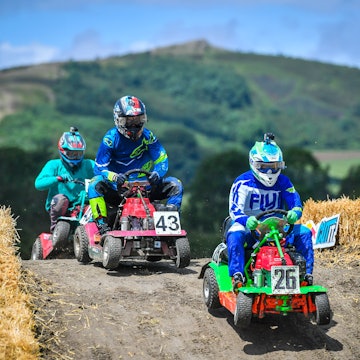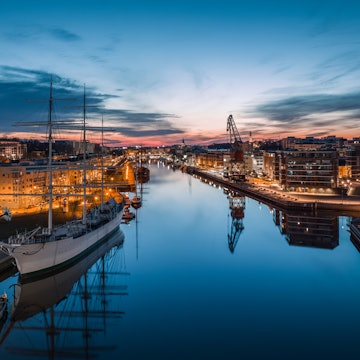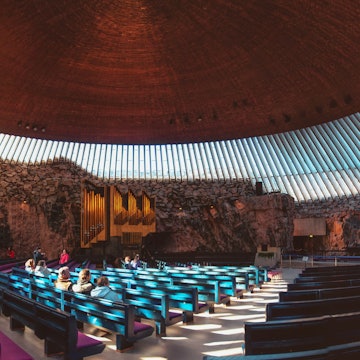
Finland’s best hikes: from high Arctic fells to fantasy forests

May 29, 2022 • 10 min read

If you’re welling to pile on the layers and strap on the snowshoes, Finland offers wondrous winter hikes © BlueOrange Studio / Shutterstock
Finland reserves its true beauty for those who are willing to walk.
Strike out on foot into the wilds of its stupendous national parks and you’ll get an inkling of the country’s vast scale, liberating remoteness and mind-cleansing solitude. You’re nearly always in the middle of nowhere – and that’s just fine. The nature-obsessed Finns have taken great pains to ensure that the middle of nowhere has well-marked trails, handy bridges leaping across raging rivers, boardwalks skipping across the swamps, and wilderness huts where you camp the night with just an open fire, the stars and the rustles and snuffles of unfamiliar animals for company.
Peak walking season is from May to October – or late June to September in the Arctic north – but winter can be wondrous too if you’re willing to swap hiking boots for snowshoes or cross-country skis. From the Arctic fells (mountaintops) and tundra of Lapland to the lichen-draped boreal forests and true-blue lakes in the east where Finland nudges Russia, and the island-speckled Baltic down south, we’ve rounded up these itineraries, the best hikes in Finland.
St Olav Waterway is the best coastal hike
106km (66 miles); 4–5 days; moderate to demanding
One of Finland’s newest hikes, the coast-hugging St Olav Waterway pilgrimage trail appeals to anyone’s inner Viking as it slips from island to gorgeous Baltic island off Finland’s southwest coast and into neighboring Sweden, before making its way to Trondheim in Norway. Named after the 11th-century Viking warrior St Olav, king and patron saint of Norway, the full route is 643km (400 miles) long, but this four-day section gives you a great taster. Don’t rush, however: these are coast-scapes to relish slowly, perhaps factoring in a night or two in a summer cottage en route.
Kicking off at the Gothic cathedral in the seafaring city and former Finnish capital of Turku, the trail hopscotches across the lushly forested islands sprinkling the sapphire-blue sea unfurling southwest, including Nagu, with its medieval church, and Korpo, with its gently shelving beaches. Saunas, swims and nights under the stars await. The wildlife is pretty special, too: keep an eye out for migratory birds (including cranes), deer and elk.

Spot abundant wildlife on Karhunpolku (Bear’s Trail)
133km (83 miles); 7 days; moderate
The densely forested wilds of Russia are but a whisper away on the staggeringly remote Karhunpolku (Bear’s Trail), which hugs borderlands as it unspools through national parks and nature reserves, far removed from the buzz of civilization (though not, alas, the buzz of mosquitoes).
Well marked with orange circles and poles, this is a moderately challenging week-long stomp, full of moments you won’t forget in a hurry – be it a brown bear roaming in the distance as dawn breaks in the boreal forest, or a fleeting glance of an elk, reindeer or wolverine in the honeyed light of dusk. The wildlife loves the solitude and swamps here – and so will you. Bring binoculars, a camera and a decent map to launch yourself into the great green unknown.
The trail begins and ends in the back of beyond. You’ll start in Patvinsuo National Park (a real feast for wildlife watching) and end in Teljo in Sotkamo, near the Lieksa-Kuhmo Road. En route you’ll pass the Pitkäjärvi Wilderness Hut, an idyllic lakeside log cabin, and Ruunaa Hiking Center, where you can stop the night to forage, fish, canoe, white-water-raft the rapids of Lieksanjoki River and relax in a sauna. Then it’s on to the military fortifications of Änäkäinen before the final stretch through upliftingly lovely old-growth forest. Overall, the hike is easygoing, though there is the occasional steep ridge to climb.
For a great mountain climb, tackle the Mt Halti trek
14km (8.6 miles), 5–6 hours; moderate
So Finland’s highest peak is actually in…Norway. At least technically: Mt Halti pops up right on the border in the extreme northwest of Finnish Lapland. While much of the mountain lies in Finland, the actual summit, 1365m (4478ft) Ráisduattarháldi, pokes its head out over the Norwegian border. Even when topographically torn, this special place shines a light on the wilderness high above the Arctic Circle.
The Finnish name Haltiatunturi means “fairy mountain” – and the real magic comes when you reach its rocky, cairn-topped summit and staggering views open up south across the lonely fells of Lapland and northwest to Norway’s glittering Lyngen Fjord. But first you have to climb it.
If you go full multi-day, wild-camping hog, this is a serious undertaking, but the day hike to the top demands only a more moderate level of fitness. That said, given the harsh climate, exposed terrain and slippery scree you’ll have to traverse, this is one best walked from late June to September – go before and it’s likely to be wet; go after and it’s likely to be freezing cold. Stick to the trail, as reindeer graze in the area. In early autumn you can stop to feast on bilberries.
Reach new Arctic highs on the UKK Route
112km (70 miles); moderate–demanding
In a country of endless forest and lakes and beautiful nothingness, there is hot competition for the title of Finland’s best hike – and the UKK Route is a major contender. In the country’s northeast, this itinerary stretches from Naruska to Tulppio and dips into Tuntsa Wilderness Area, letting you slip properly off the radar and back to nature. By night, there are sheltered areas where you can camp and gaze up at the big old night sky.
Largely following orange-red markings and best hiked in summer, the trail shadows the sprightly River Naruskajoki in the lowlands, picking up pace as it weaves north to scale fells. The utter silence and last-person-left-on-earth feeling is refreshing as you pick your way through primeval landscapes of pine forest, lichen heathland, mossy tundra and swampland. When you find yourself alone – as is often the case – you can almost forget what century we’re living in.
You’ll need to be in good physical shape to tackle some stiff climbs and rough terrain, and be able to navigate sections where the trail is overgrown. The stark Arctic environment should never be taken lightly; the names of geographical features like Pahakuru (evil gorge) and Kylmähete (cold pond) bear testament to this. Duckboards cross the boggiest ground, but rubber boots are still handy if you want dry feet.

Cross rocks and rivers along Karhunkierros (The Bears’ Ring)
82km (51 miles); 3–4 days
Of all Finland’s hikes, Karhunkierros gets the most love, and it’s wholly deserved. Whisking you through tremendously wild landscapes in Oulanka National Park on the Russian border in the country’s northeast, the trail is Finnish nature in overdrive. This was Sámi territory until the 17th century – and the nomadic spirit lives on. Rivers and rapids surge past cliffs, gorges, rock formations and dense boreal forest of pine, birch and spruce. The rush of water is often the only sound you will hear.
Starting in the village of Hautajärvi and ending at Rukatunturi fell, the trail swings from gentle to moderate in difficulty as the terrain changes. There are open moorlands to traverse, hanging bridges to cross and cottongrass-stippled swamps to negotiate, as well as few hills tossed in toward the end to ramp up the challenge.
Crossing rugged, red Oulanka Canyon, seeing Jyrävä waterfall crash through forest and over boulders, and climbing up to the 491m (1611ft) peak of Valtavaara are moments you’ll rave about. There’s some fantastic plant and wildlife, too – brown bears, reindeer and elk hang out in the park, and birders can look out for Siberian jays and capercaillies. In summer, Oulanka is a mass of bilberries and wild orchids.
It is best to hike the trail from late June onwards, but you’ll share it with the sand flies, mosquitoes and midges in summer. Early autumn is glorious for foliage: just make sure you wear bright clothing during moose-hunting season. The trail is doable in winter with snowshoes and skis if you’re very experienced, but there’s little light during the polar night and temperatures can plummet to a numbingly cold -40°C (-40°F).
Pohjantikan Kierros is a terrific hike for families
4.5km (2.8 miles); 2 hours; easy
Midway between Turku and Helsinki, petite and pretty Liesjärvi National Park is wonderfully accessible for families. Flat and easy to follow, this two-hour ramble is a great, no-stress way to introduce kids to Finnish nature. Only if you can drag yourselves away from the trailhead, that is: the rustic Korteniemi Heritage Farm on a century-old forest ranger’s estate, where there are farm animals to meet, fresh produce to buy and crops still farmed the traditional way.
From here, blue-diamond-marked paths and boardwalks take you into a Tolkien fantasy of old-growth forest, full of wacky mushrooms, hairy lichens and spongy mosses. Listen out for the hammer of woodpeckers and the boo-boo-boo of the Tengmalm's Owl. If your timing is spot on, you might even see a flying squirrel. The woods open into a meadow, which you cross to reach the shores of Lake Liesjärvi, perfect for a cooling, end-of-walk swim in the height of summer.

The Hetta–Pallas Trail is a superior best fell-to-fell hike
55km (34 miles); 4 days; easy–moderate
Though Finland is a country of forests rather than mountains, this walk keeps you on a high pretty much all the way. Diving deep into the Pallas-Yllästunturi National Park in the Arctic wilds of western Lapland, the Hetta-Pallas Trail leads up and over one windswept fell to the next, each one presenting a stirring view of old-growth taiga forest, bilberry-blanketed bogs or rolling tundra where Sámi reindeer herds graze freely. It is never lovelier than during the fall foliage, or ruska, when the landscape glows red and gold. As you stride along, take a deep breath: scientists at local research stations have discovered that this region of Finland has the world’s cleanest air.
Beginning in the village of Hetta, the hike begins with a boat crossing of Lake Ounasjärvi, before heading on to the wilderness hut at Pyhäkero and surmounting the fell of the same name, which has astonishing views across a ripple of fells all the way to the Norwegian and Swedish borders. The following days as you push on to Pallas follow a similar pattern, taking you from wilderness hut to fell and through some sensational Arctic landscapes: spruce forests fuzzy with lichen, gnarled birches and cottongrass-flecked aapa mires where you can gorge on bilberries, bearberries and cloudberries in summer.
The hike is overall gentle, with a few longish climbs and descents to tackle. Boardwalks keep your feet dry on the wettest stretches. June to September is the best time to walk it, capitalizing on the daylight and making it a genuine pleasure to stay at the wilderness huts and campfire sites (bonus: firewood is provided) en route.
Push your limits on the Kevo Canyon Trail
64km (40 miles); 3–5 days; demanding
Throwing you in at the Arctic deep end, this physically tough, scenically rewarding hike leads through the Kevo Strict Nature Reserve, tucked into the northernmost pocket of Finnish Lapland. Some of Finland’s most breathtaking landscapes hit you as you step through birch forests, puff up open fells, traverse tundra-like mires and wade through streams (taking care not to get swept away by the current when water levels are high) on the trail from Sulaoja to Kenesjärvi.
But what really lodges this hike in your memory is its namesake canyon, 70 million years in the making, whose high rock walls bearing the scars of the last Ice Age seem to silence the world beyond. At roughly the halfway point, you’ll stop dead in your tracks as the Fiellujoki River plunges into the canyon in a double cascade.
Big wildlife rules here: wolverines, brown bears, Arctic foxes, lynx and otters at ground and river level; rough-legged buzzards and merlins nesting in the canyon’s cliffs; and bar-tailed godwits, jacksnipes and broad-billed sandpipers in the mires. All of which means you shouldn’t stray from well-marked trail (not even to snaffle a tasty berry).
This is one of Finland’s epic hikes, but you won’t earn it easily: the terrain is tough, with plenty of ups and downs, slippery, exposed sections and fords. A map (try 1:100,000 Utsjoki Kevo outdoor map) and compass are advisable, as is a tent as there’s only one wilderness hut along the main route.















